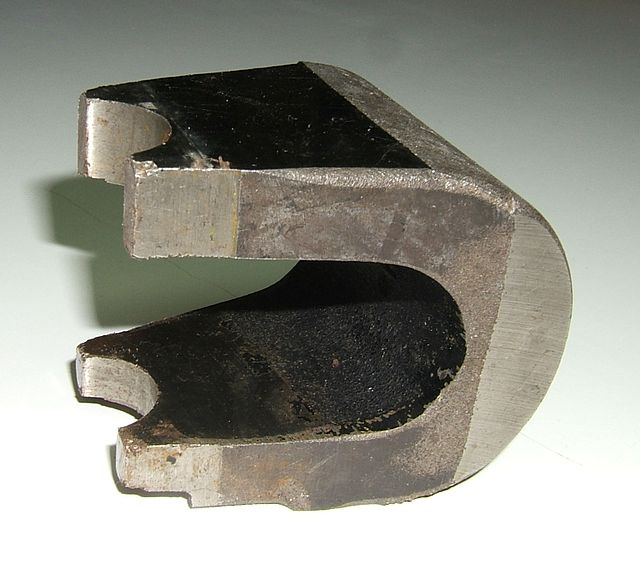Alnico is a family of iron alloys which, in addition to iron are composed primarily of aluminium (Al), nickel (Ni), and cobalt (Co), hence the acronym al-ni-co. They also include copper, and sometimes titanium. Alnico alloys are ferromagnetic, and are used to make permanent magnets. Before the development of rare-earth magnets in the 1970s, they were the strongest permanent magnet type. Other trade names for alloys in this family are: Alni, Alcomax, Hycomax, Columax, and Ticonal.
A "horseshoe magnet" made of Alnico 5, about 1 inch high. The metal bar (bottom) is a keeper, which is placed across the poles when the magnet is not in use. This helps to preserve the magnetization.
Alnico 5 magnet used in a magnetron tube in an early microwave oven. About 3 in (8 cm) long.
Advertisement by Jensen Radio Manufacturing Co. for Alnico 5 loudspeakers in 1945. As illustrated, Alnico 5 allowed a dramatic reduction in size and weight of magnet needed to produce a given flux, from 90 oz in 1930 to 4.6 oz.
Assortment of Alnico magnets in 1956. Alnico 5, developed during World War 2, led to a new generation of compact permanent magnet motors and loudspeakers.
Nickel is a chemical element; it has symbol Ni and atomic number 28. It is a silvery-white lustrous metal with a slight golden tinge. Nickel is a hard and ductile transition metal. Pure nickel is chemically reactive, but large pieces are slow to react with air under standard conditions because a passivation layer of nickel oxide forms on the surface that prevents further corrosion. Even so, pure native nickel is found in Earth's crust only in tiny amounts, usually in ultramafic rocks, and in the interiors of larger nickel–iron meteorites that were not exposed to oxygen when outside Earth's atmosphere.
Nickel
Electron micrograph of a Ni nanocrystal inside a single wall carbon nanotube; scale bar 5 nm
Widmanstätten pattern showing the two forms of nickel–iron, kamacite and taenite, in an octahedrite meteorite
Color of various Ni(II) complexes in aqueous solution. From left to right, [Ni(NH3)6]2+, [Ni(NH2CH2CH2NH2)]2+, [NiCl4]2−, [Ni(H2O)6]2+








![Color of various Ni(II) complexes in aqueous solution. From left to right, [Ni(NH3)6]2+, [Ni(NH2CH2CH2NH2)]2+, [NiCl4]2−, [Ni(H2O)6]2+](https://upload.wikimedia.org/wikipedia/commons/thumb/f/ff/Color_of_various_Ni%28II%29_complexes_in_aqueous_solution.jpg/640px-Color_of_various_Ni%28II%29_complexes_in_aqueous_solution.jpg)